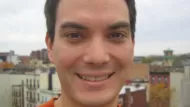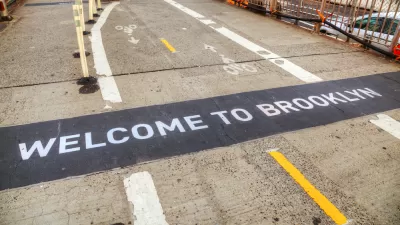A friend introduced me yesterday to rambunctious bicycling advocate Fred Oswald via a recent article out of Cleveland’s press. Much debate swirls around his not-so-uncommon opinions. Mr. Oswald’s argument can be boiled down to two points: supporting a critical need for much more bicycling education on sharing public roadways with other vehicles, and fighting an industry-borne fallacy that breaking up streets with allocated spaces, such as bike lanes, is good for the biking community. The former is, of course, not contestable. We all agree that safety and training are absolutely critical to developing a strong and healthy bicycling community.
A friend introduced me yesterday to rambunctious bicycling advocate Fred Oswald via a recent article out of Cleveland's press. Much debate swirls around his not-so-uncommon opinions. Mr. Oswald's argument can be boiled down to two points: supporting a critical need for much more bicycling education on sharing public roadways with other vehicles, and fighting an industry-borne fallacy that breaking up streets with allocated spaces, such as bike lanes, is good for the biking community. The former is, of course, not contestable. We all agree that safety and training are absolutely critical to developing a strong and healthy bicycling community. The latter, however, is a serious point of contention in the transportation profession, and deserves discussion. Categorically declaring bike lanes counter-productive is lacking nuance and myopically idealistic; it simply does not reflect where we are as a nation of people on the move. When it comes to the idea of bicycles and automobiles co-existing, that is, equally sharing a common public space, we Americans are but toddlers learning to get our balance; therefore, we still need training wheels. And training wheels in this metaphor take the form of two parallel stripes called bike lanes.
As a fellow engineer, I am compelled to say that I totally empathize with the argument. Indeed, in an ideal world where everyone acknowledges that bicyclists deserve the same access to, and use of, public rights-of-way as motorists, we would not need to reapportion pavement into exclusive modal fragments. But in typical engineer fashion, this narrow focus on ideal conditions fails to consider the current status of bicyclist/driver relations. Drivers are confused, at best, with bicyclists on "their" streets (angry at their interference, at worst), and bicyclists are summarily fearful of drivers. The result is many would-be daily bicyclists overlook that excellent means of commuting for another mode of transport, most often the car.
Status-quo geometric design is not going to get more bikes on the road than there are brave messenger jobs and aggressive enthusiasts. The average person is just not that daring. After decades of our industry designing roadways for the efficient throughput of cars, bicycling has been all but marginalized. Without words, we have sent a message that streets are for cars, fast and plentiful. Efforts to try to communicate something different can not effectively be done with "Share the Road" signage and billboards alone. To overcome the conditioning of decades, we must send a message loud and clear, in the most direct way possible. Rather than creating a safe space on the street for bicyclists – which is not the function of bike lanes and should not be promoted as such – bike lanes vividly transmit a message to both drivers and potential bicyclists that "Hey, this street is for both cars and bikes; bikes have a right to be here just as much as cars do!"
After years of posting "Bike Route" signage throughout New York City boroughs with little to no impact on ridership, look to that city's recent surge in bicycling volumes as bike lanes are striped at an astonishing pace for evidence of the overwhelmingly effective message sent by bike lanes. In my hometown of Hoboken, the recent addition of bike lanes on two streets instantaneously resulted in slower speeds on those streets (full disclosure: this is based on residents' anecdotes, not a speed study). Following the industry's accepted prescription, narrower lanes in the form of an added bike lane increase the so-called "perceived risk" of drivers, along with their awareness of other uses on the street, and therefore vehicle speeds inversely decrease.
Finally, with the installation of bike lanes, it is true as Mr. Oswald says, that "Fools rush in!". But I contend that fools are exactly what we want: people new to biking, choosing that mode over a car, and learning how to share the road as bicyclists rather than drivers. Yes, a strong education and safety program is equally important, but welcoming new bicyclists to the street is most desirable because, as concluded in study after study, the most powerful way to reduce bicycle/vehicle fatalities and increase driver awareness of bicycles is by getting more bikes on the road, commonly referred to as the "Safety in Numbers" effect.
Bike lanes are not a safety device, they are a bullhorn. In a future where the message is implicit, bike lanes may be unnecessary. But for now, despite not being a perfect solution, they are an effective and important tool in the engineer's toolbox, and should be used as such.
P.S. Sorry for no photos this time to break up the babble!

Planetizen Federal Action Tracker
A weekly monitor of how Trump’s orders and actions are impacting planners and planning in America.

Congressman Proposes Bill to Rename DC Metro “Trump Train”
The Make Autorail Great Again Act would withhold federal funding to the system until the Washington Metropolitan Area Transit Authority (WMATA), rebrands as the Washington Metropolitan Authority for Greater Access (WMAGA).

The Simple Legislative Tool Transforming Vacant Downtowns
In California, Michigan and Georgia, an easy win is bringing dollars — and delight — back to city centers.

The States Losing Rural Delivery Rooms at an Alarming Pace
In some states, as few as 9% of rural hospitals still deliver babies. As a result, rising pre-term births, no adequate pre-term care and harrowing close calls are a growing reality.

The Small South Asian Republic Going all in on EVs
Thanks to one simple policy change less than five years ago, 65% of new cars in this Himalayan country are now electric.

DC Backpedals on Bike Lane Protection, Swaps Barriers for Paint
Citing aesthetic concerns, the city is removing the concrete barriers and flexposts that once separated Arizona Avenue cyclists from motor vehicles.
Urban Design for Planners 1: Software Tools
This six-course series explores essential urban design concepts using open source software and equips planners with the tools they need to participate fully in the urban design process.
Planning for Universal Design
Learn the tools for implementing Universal Design in planning regulations.
Smith Gee Studio
City of Charlotte
City of Camden Redevelopment Agency
City of Astoria
Transportation Research & Education Center (TREC) at Portland State University
US High Speed Rail Association
City of Camden Redevelopment Agency
Municipality of Princeton (NJ)




























